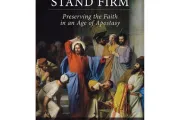Our word “liturgy” comes from a Greek word which means “public duty” or “public work.” Used in reference to Holy Church, it means the forms of prayer, acts and ceremonies used in her public and official worship. The liturgy includes the praying of the Divine Office, the administration of the Sacraments and, most particularly, the celebration of the Eucharistic Sacrifice, the Mass.
In The Spirit of the Liturgy, the future Benedict XVI uses “liturgy” in this last sense; he makes clear his concern for the way in the Mass has been celebrated. In the book’s preface, he employs the striking metaphor of a whitewashed fresco to describe the situation of the liturgy during the Twentieth Century:
[The fresco] had been preserved from damage, but it had been almost completely overlaid with whitewash …. In the Missal from which the priest celebrated, the form of the liturgy that had grown from its earliest beginnings was still present, but, as far as the faithful were concerned, it was largely concealed beneath instructions for and forms of private prayer. The fresco was laid bare by the Liturgical Movement and, in a definitive way, by the Second Vatican Council. For a moment its colors and figures fascinated us. But since then the fresco has been endangered by climatic conditions as well as by various restorations and reconstructions. In fact, it is threatened with destruction, if the necessary steps are not taken to stop these damaging influences. Of course, there must be no question of its being covered with whitewash again, but what is imperative is a new reverence in the way we treat it, a new understanding of its message and its reality, so that rediscovery does not become the first stage of irreparable loss. [pp. 7-8]
In the latter sections of the book, he offers us patient, detailed instruction on such contentious issues as “The Altar and Direction of Liturgical Prayer,” “The Reservation of the Blessed Sacrament,” “The Question of Images,” “Music and Liturgy,” “Active Participation,” “Kneeling” and “Standing and Sitting.” He discusses the origins and meaning of authentic Catholic practice in these areas, often revealing the surprising – and sometimes well-meaning – motives behind some unfortunately widespread deviations.


